
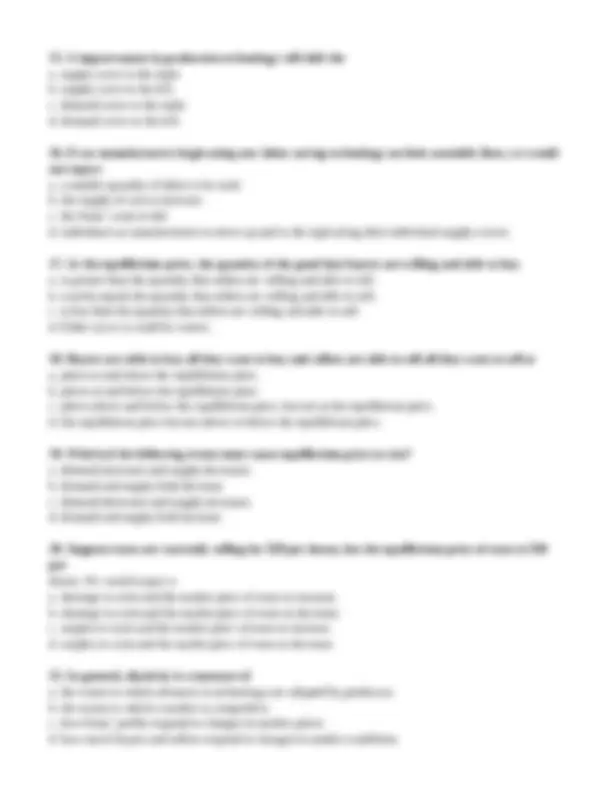
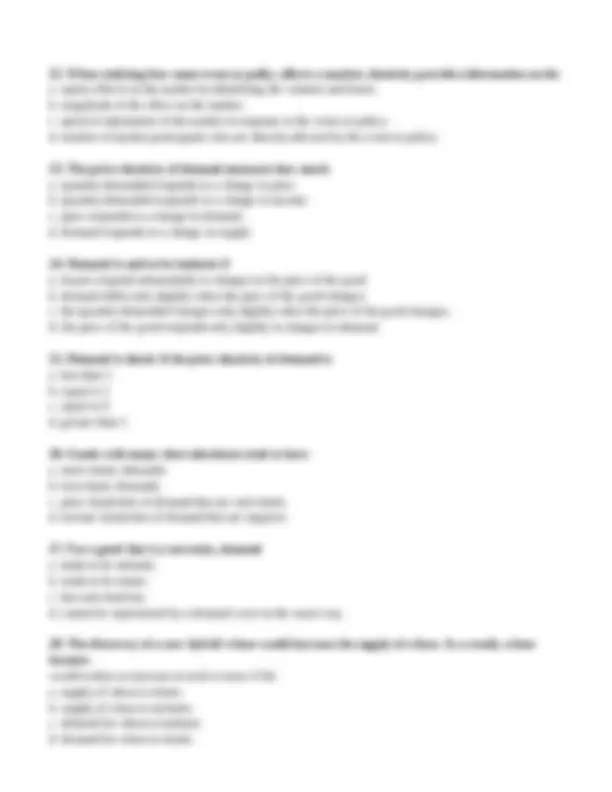
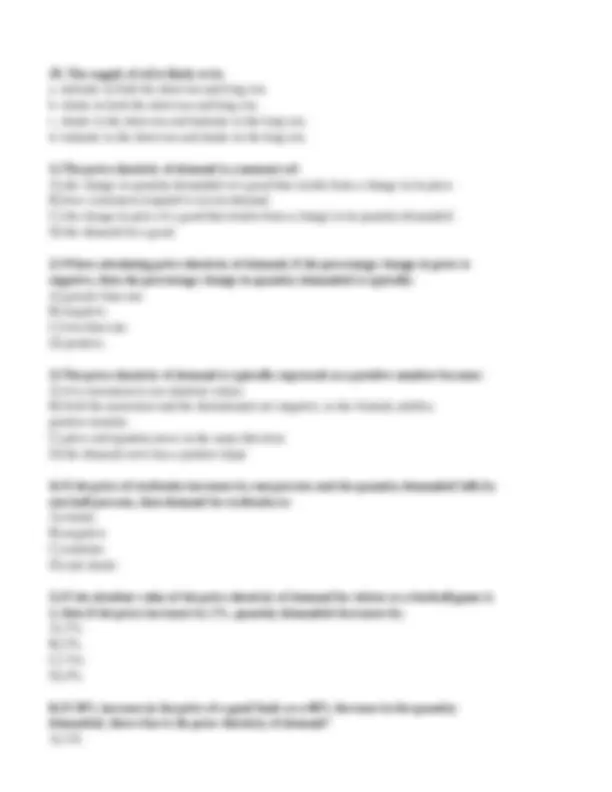
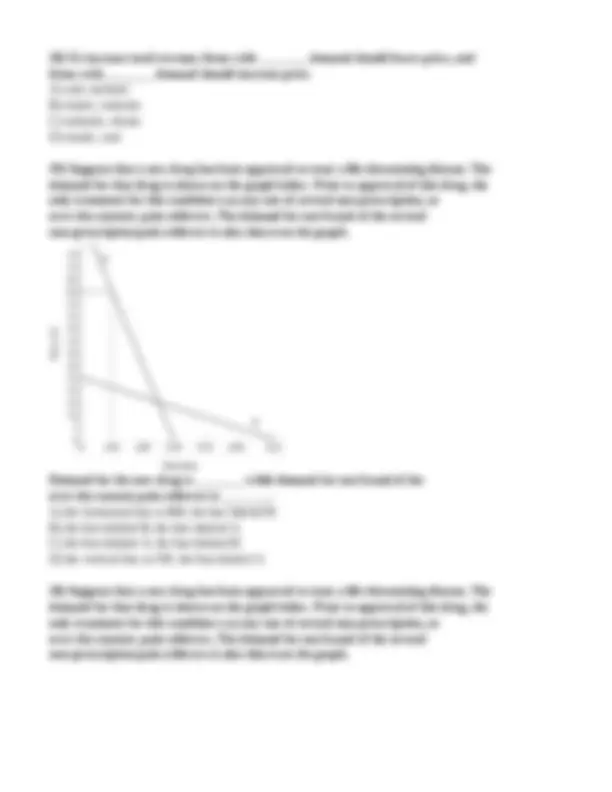
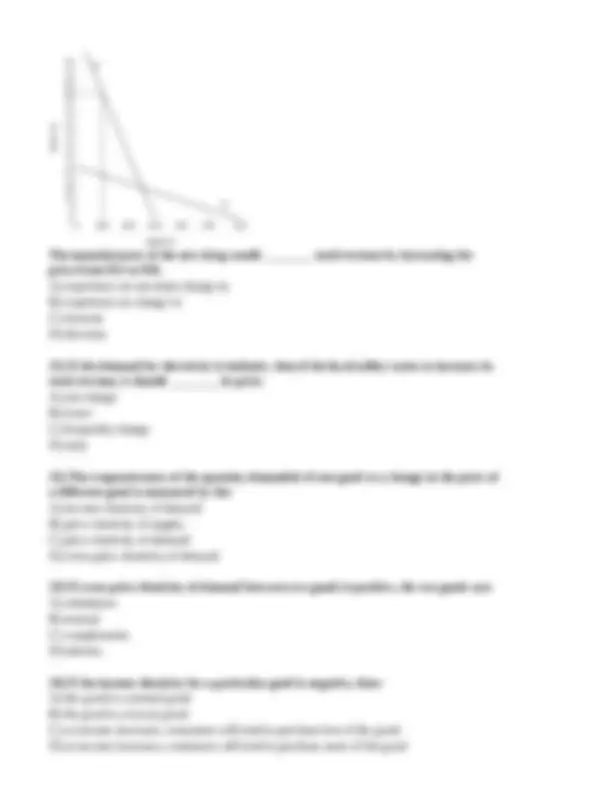
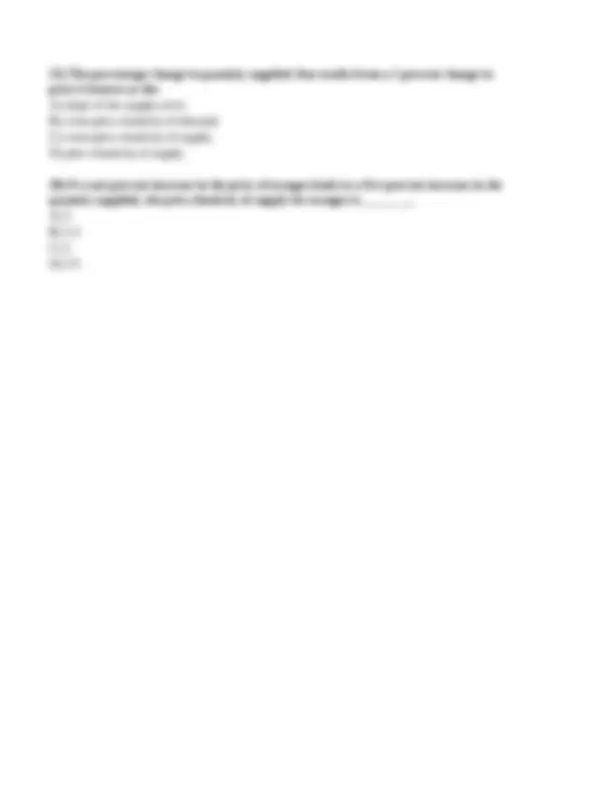


Study with the several resources on Docsity

Earn points by helping other students or get them with a premium plan


Prepare for your exams
Study with the several resources on Docsity

Earn points to download
Earn points by helping other students or get them with a premium plan
Community
Ask the community for help and clear up your study doubts
Discover the best universities in your country according to Docsity users
Free resources
Download our free guides on studying techniques, anxiety management strategies, and thesis advice from Docsity tutors
An overview of the key concepts related to demand and supply in a competitive market. It covers topics such as how supply and demand determine prices, the characteristics of a competitive market, the law of demand, the demand curve, the market demand curve, the quantity supplied, and the equilibrium price. The document also discusses the concept of elasticity, including price elasticity of demand, and how it measures the responsiveness of buyers and sellers to changes in market conditions. Overall, this document offers a comprehensive understanding of the fundamental principles governing the dynamics of supply and demand in a competitive market environment.
Typology: Quizzes
1 / 10

This page cannot be seen from the preview
Don't miss anything!







1. In a market economy, supply and demand determine a. both the quantity of each good produced and the price at which it is sold. b. the quantity of each good produced but not the price at which it is sold. c. the price at which each good is sold but not the quantity of each good produced. d. neither the quantity of each good produced nor the price at which it is sold. 2. In a market economy, a. supply determines demand and demand, in turn, determines prices. b. demand determines supply and supply, in turn, determines prices. c. the allocation of scarce resources determines prices and prices, in turn, determine supply and demand. d. supply and demand determine prices and prices, in turn, allocate the economy’s scarce resources. 3. In a competitive market, the price of a product a. is determined by buyers, and the quantity of the product produced is determined by sellers. b. is determined by sellers, and the quantity of the product produced is determined by buyers. c. and the quantity of the product produced are both determined by sellers. d. None of the above is correct. 4. A competitive market is a market in which a. an auctioneer helps set prices and arrange sales. b. there are only a few sellers. c. the forces of supply and demand do not apply. d. no individual buyer or seller has any significant impact on the market price. 5. Assume Diana buys computers in a competitive market. It follows that a. Diana has a limited number of sellers to turn to when she buys a computer. b. Diana will find herself negotiating with sellers whenever she buys a computer. c. if Diana buys a large number of computers, the price of computers will rise noticeably. d. None of the above is correct. 6. An increase in quantity demanded a. results in a movement downward and to the right along a demand curve. b. results in a movement upward and to the left along a demand curve. c. shifts the demand curve to the left. d. shifts the demand curve to the right. 7. When the price of a good or service changes, a. the supply curve shifts in the opposite direction. b. the demand curve shifts in the opposite direction. c. the demand curve shifts in the same direction. d. there is a movement along a given demand curve.
8. The law of demand states that, other things equal, an increase in a. price causes quantity demanded to increase. b. price causes quantity demanded to decrease. c. quantity demanded causes price to increase. d. quantity demanded causes price to decrease. 9. The demand curve for a good is a line that relates a. price and quantity demanded. b. income and quantity demanded. c. quantity demanded and quantity supplied. d. price and income. 10. When quantity demanded increases at every possible price, the demand curve has a. shifted to the left. b. shifted to the right. c. not shifted; rather, we have moved along the demand curve to a new point on the same curve. d. not shifted; rather, the demand curve has become steeper 11. The market demand curve a. is the sum of all individual demand curves. b. is the demand curve for every product in an industry. c. shows the average quantity demanded by individual demanders at each price. d. is always flatter than an individual demand curve. 12. The quantity supplied of a good is the amount that a. buyers are willing and able to purchase. b. sellers are able to produce. c. buyers and sellers agree will be brought to market. d. sellers are willing and able to sell 13. Which of the following would cause a movement along the supply curve for cupcakes? a. an improvement in technology for commercial mixers b. a decrease in the price of cupcakes c. an increase in the price of cake flour d. All of the above are correct. 14. Which of these statements best represents the law of supply? a. When input prices increase, sellers produce less of the good. b. When production technology improves, sellers produce less of the good. c. When the price of a good decreases, sellers produce less of the good. d. When sellers’ supplies of a good increase, the price of the good increases.
22. When studying how some event or policy affects a market, elasticity provides information on the a. equity effects on the market by identifying the winners and losers. b. magnitude of the effect on the market. c. speed of adjustment of the market in response to the event or policy. d. number of market participants who are directly affected by the event or policy. 23. The price elasticity of demand measures how much a. quantity demanded responds to a change in price. b. quantity demanded responds to a change in income. c. price responds to a change in demand. d. demand responds to a change in supply 24. Demand is said to be inelastic if a. buyers respond substantially to changes in the price of the good. b. demand shifts only slightly when the price of the good changes. c. the quantity demanded changes only slightly when the price of the good changes. d. the price of the good responds only slightly to changes in demand. 25. Demand is elastic if the price elasticity of demand is a. less than 1. b. equal to 1. c. equal to 0. d. greater than 1 26. Goods with many close substitutes tend to have a. more elastic demands. b. less elastic demands. c. price elasticities of demand that are unit elastic. d. income elasticities of demand that are negative. 27. For a good that is a necessity, demand a. tends to be inelastic. b. tends to be elastic. c. has unit elasticity. d. cannot be represented by a demand curve in the usual way. 28. The discovery of a new hybrid wheat would increase the supply of wheat. As a result, wheat farmers would realize an increase in total revenue if the a. supply of wheat is elastic. b. supply of wheat is inelastic. c. demand for wheat is inelastic. d. demand for wheat is elastic.
29. The supply of oil is likely to be a. inelastic in both the short run and long run. b. elastic in both the short run and long run. c. elastic in the short run and inelastic in the long run. d. inelastic in the short run and elastic in the long run. 1) The price elasticity of demand is a measure of: A) the change in quantity demanded of a good that results from a change in its price. B) how consumers respond to excess demand. C) the change in price of a good that results from a change in its quantity demanded. D) the demand for a good. 2) When calculating price elasticity of demand, if the percentage change in price is negative, then the percentage change in quantity demanded is typically: A) greater than one. B) negative. C) less than one. D) positive. 3) The price elasticity of demand is typically expressed as a positive number because: A) it's convenient to use absolute values. B) both the numerator and the denominator are negative, so the formula yields a positive number. C) price and quantity move in the same direction. D) the demand curve has a positive slope 4) If the price of textbooks increases by one percent and the quantity demanded falls by one-half percent, then demand for textbooks is: A) elastic. B) negative. C) inelastic. D) unit elastic 5) If the absolute value of the price elasticity of demand for tickets to a football game is 2, then if the price increases by 1%, quantity demanded decreases by: A) 1%. B) 2%. C) ½%. D) 4%. 6) If 20% increase in the price of a good leads to a 60% decrease in the quantity demanded, then what is the price elasticity of demand? A) 1/6.
13) Suppose the price of a Snickers candy bar is $2.00 at both the airport and the grocery store. The price elasticity of demand for a Snickers candy bar at an airport is likely to be ________ the price elasticity of demand for a Snickers candy bar at the grocery store. A) equal to B) greater than C) less than D) the reciprocal of 14) Demand tends to be ________ in the short run than in the long run. A) more variable B) less important C) less elastic D) more elastic 15) Assume the price of gasoline doubles tonight and remains at that price for the next two years. Compared with the long-run price elasticity of demand for gasoline, the short-run price elasticity of demand for gasoline will be ________. A) more variable B) the same C) lower D) higher 16) Economists have found that the price elasticity of demand for water is higher in the summer than in the winter. Why is this likely to be so? A) Winter is longer than summer, and price elasticity is lower over longer time horizons. B) People take more vacations in the summer and so use less water at home. C) Winter water use tends to be for necessities such as cleaning and cooking, and summer water use tends to be for both necessities and non-necessities such as gardening and recreation. D) Summer is longer than winter, and price elasticity is higher over longer time horizons. 17) If demand is ________ with respect to price, a price increase will ________ total revenue. A) elastic; increase B) inelastic; increase C) inelastic; decrease D) unit elastic; decrease
18) To increase total revenue, firms with ________ demand should lower price, and firms with ________ demand should increase price. A) unit; inelastic B) elastic; inelastic C) inelastic; elastic D) elastic; unit 19) Suppose that a new drug has been approved to treat a life-threatening disease. The demand for that drug is shown on the graph below. Prior to approval of this drug, the only treatment for this condition was any one of several non-prescription, or over-the-counter, pain relievers. The demand for one brand of the several non-prescription pain relievers is also shown on the graph. Demand for the new drug is ________ while demand for one brand of the over-the-counter pain relievers is ________. A) the horizontal line at $60; the line labeled B B) the line labeled B; the line labeled A C) the line labeled A; the line labeled B D) the vertical line at 100; the line labeled A 20) Suppose that a new drug has been approved to treat a life-threatening disease. The demand for that drug is shown on the graph below. Prior to approval of this drug, the only treatment for this condition was any one of several non-prescription, or over-the-counter, pain relievers. The demand for one brand of the several non-prescription pain relievers is also shown on the graph.
25) The percentage change in quantity supplied that results from a 1 percent change in price is known as the: A) slope of the supply curve. B) cross-price elasticity of demand. C) cross-price elasticity of supply. D) price elasticity of supply. 26) If a one percent increase in the price of oranges leads to a five percent increase in the quantity supplied, the price elasticity of supply for oranges is ________. A) 5 B) 1/ C) 2 D) 1/